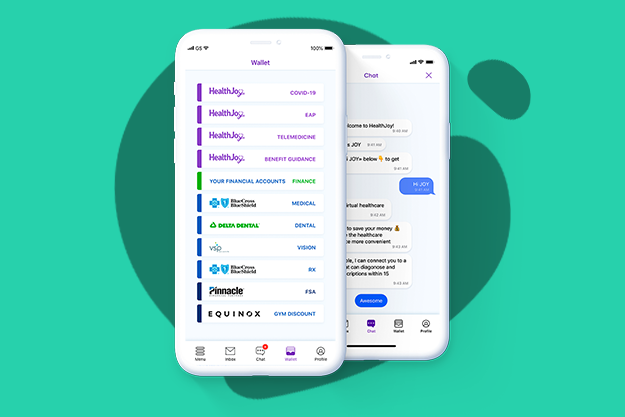1 min read
How Our Benefits Wallet Engages Employees
Building a genuinely satisfying employee benefits package is at the top of every HR professional’s mind, but getting there is harder than ever...
Connected Navigation Platform
Guiding to high-value care
Behavioral Health
Foster a mentally healthy workplace
EAP
Supporting holistic wellbeing
Virtual MSK Care
Reimagining musculoskeletal care
Virtual Primary Care
Powered by smart navigation
Surgery Centers of Excellence
Best-in-class surgical outcomes
Virtual Urgent Care
Immediate care, any hour of the day
Chronic Care
A new approach to chronic care
Integrations
Flexible to any strategy

How can you strategize to achieve your OE goals? Whether you want to drive utilization, contain costs, or improve employee satisfaction next year, these 2021 open enrollment tips can help. In Part 2, we’ll dig into what our survey revealed about how to get there.
As we detailed in Part 1 of this series, we’re heading into an Open Enrollment (OE) with high stakes and more challenges than ever before. And, as our State of the Benefits Experience Report revealed, most HR leaders are planning to head into this unusual time without new benefits or tools.
Since we asked so many HR pros already, we’ll ask you: how would you rate your benefits education strategy? If the answer isn’t 5/5, it’s time to examine some areas of improvement. Sure, the barriers presented by fully remote work, upended routines, and a crisis that rightfully occupies employee attention are significant. But with these open enrollment tips, creating an OE strategy that works in These Times is possible.
Most employers we surveyed haven’t tapped into mobile-friendly communication solutions like SMS messages and chat tools. According to App Annie, Zoom’s app topped download charts throughout February and March, and other apps like Google’s Meet and Microsoft’s Teams surged, too. General announcements, like enrollment dates or company-wide plan change details, are ideal candidates for these tools. What’s more, mobile devices in 2020 now generated 51.92 percent of global website traffic, so a well designed mobile strategy is vital (see The Best Benefits Engagement Tool You Haven’t Used for more). The best part? They meet employees wherever in the (work from home) world they are.
This isn’t the year to get into the weeds in all your communications. Employees are juggling more than ever before, both at work and home, and their attention spans are short. Give them only the basics during OE. Then, make sure they’re supported by a benefits administration system or benefits experience platform that provides navigation support. Employees won’t need details until they REALLY need details; that’s where navigation becomes key. For detailed tips, read our post How to Simplify Benefits Communications for Open Enrollment.
Our survey uncovered that HR spends an average of 9 hours per week answering benefits questions. Some outliers reported spending 20, 30, or even 40 hours per week on this task. The short window of OE is your chance to get ahead of these questions. This might be harder to accomplish in 2020. But laying the groundwork with these open enrollment tips just may cut down on questions later. Trust us; your future self will be thankful.
During this open enrollment, plan to be more available than ever before. Employees can’t just head down the hall to an open enrollment meeting, and if their parents, jumping on a virtual call might be difficult. What’s more, employees are experiencing “Zoom fatigue” at a rate that makes virtual meetings a questionable method of communication, at best. Unfortunately, video is what most of us are working with right now. So, plan for low attendance by opening more time in your calendar to answer questions and guide employees through your plan.
Most of our survey respondents reported using an intranet system or benefits portal. If you use one of these tools, find out whether it has the capability to host a Frequently Asked Questions section. With an FAQ at their fingertips, employees may be able to answer basic questions like “where can I get a new benefits card?” and “how can I find my deductible?” We know from the State of the Benefits Experience Survey that these questions top HR’s to-do list and, while uncomplicated, they can be tedious. Why not turn to technology to simplify the process?
We know that some questions are too personal or specific to be answered by an FAQ or even HR for that matter. This is where your benefits administrator or benefits experience platform can come to the rescue. When you outsource not just questions but navigation support to one of these services, you save time and increase employee satisfaction. Employees can get help finding their benefits cards and services, but can also find high-quality, low-cost doctors, view their HSA balance, or get support for dependents. When you consider all that 2021 is likely to throw our way, it’s clear navigation support is more essential than ever.
Employees may not feel they have time right now to consider their benefits, but you know they’ve never been more important. Our survey revealed the biggest problems with 2021 OE, including distracted employees, lack of navigation tools, and outdated education and communication strategies. Facing them down will take a bit of innovation and, in a year like this one, dedication to helping employees grasp your most essential benefits like telemedicine and EAP.
Remember that they may need more time, more empathy, and more answers than before. Above all, in your benefits communications, remember that the important thing is that they choose the best plan for them, and they know how to access care and support when they need it. With that as your focus, you can’t go wrong—no matter what else in 2020 does.

1 min read
Building a genuinely satisfying employee benefits package is at the top of every HR professional’s mind, but getting there is harder than ever...

We’re approaching 2021 open enrollment under a cloud of mental health concerns. Employees are struggling like never before, and it might feel like...

As you review your benefits education strategy, what old standouts seem too important to replace? Your strategy probably still includes favorites...